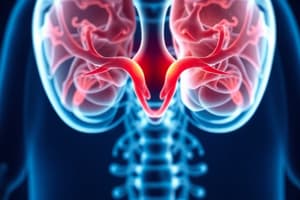Podcast
Questions and Answers
What is the hypophyseal portal system?
What is the hypophyseal portal system?
A system of blood vessels in the brain that connects the hypothalamus with the anterior pituitary.
Which of the following hormones does oxytocin stimulate?
Which of the following hormones does oxytocin stimulate?
- Lactation (correct)
- Blood pressure increase
- Water retention
- Uterine contraction (correct)
What stimulates the release of oxytocin?
What stimulates the release of oxytocin?
Distention of the cervix, contraction of the uterus, and nipple sucking.
What is the primary action of anti-diuretic hormone (vasopressin)?
What is the primary action of anti-diuretic hormone (vasopressin)?
Oversecretion of vasopressin causes diabetes insipidus.
Oversecretion of vasopressin causes diabetes insipidus.
What is the role of baroreceptors?
What is the role of baroreceptors?
What system regulates blood pressure and fluid balance?
What system regulates blood pressure and fluid balance?
Match the following hormones with their primary functions:
Match the following hormones with their primary functions:
Flashcards are hidden until you start studying
Study Notes
Hypophyseal Portal System
- A network of blood vessels linking the hypothalamus and anterior pituitary.
- Facilitates rapid hormone transport and communication between the two glands.
- Fenestrated capillaries allow efficient exchange of minimal hormone amounts.
- Hormones from the hypothalamus act on the anterior pituitary, influencing target organs.
- Supplied by branches of the internal carotid artery, including superior hypophyseal arteries.
- Blood drains from a primary capillary plexus into hypophyseal portal veins, leading to a secondary plexus that nourishes the anterior pituitary.
- Anterior pituitary cells express G protein-coupled receptors for neuropeptides, triggering hormone release.
Oxytocin
- Stimulates uterine contractions and lactation.
- Originates from supraoptic and paraventricular nuclei in the hypothalamus.
- Binds to Gq/11 protein-coupled receptors; second messenger involves phospholipase C, increasing intracellular calcium levels.
- Regulation influenced by estrogen (increases receptors) and progesterone (decreases sensitivity).
- Release triggered by cervical distention, uterine contractions, nipple stimulation, and neurotransmitters like acetylcholine and dopamine.
- Unbound form has a short half-life.
Anti-diuretic Hormone (Vasopressin)
- Promotes water retention and increases blood pressure through arteriole contraction.
- Produced in supraoptic and paraventricular nuclei.
- Insufficient vasopressin leads to diabetes insipidus, characterized by excessive dilute urine production.
- Overproduction causes the syndrome of inappropriate antidiuretic hormone (SIADH).
- Mediates effects through V2R (Gs-coupled) increasing aquaporin-2 channels and V1A (Gq/11) inducing vasoconstriction.
- V3R, in the anterior pituitary, stimulates ACTH and other hormones.
- Plasma osmolality is the primary regulator, with osmoreceptors responding to 1% changes.
- Blood volume/pressure also influences release; a 10% decrease stimulates vasopressin secretion via the renin-angiotensin system.
Baroreceptor Reflex
- Baroreceptors fire with each heartbeat at normal blood pressure levels.
- Decreased firing rate in response to low blood pressure activates reflex mechanisms to restore pressure, primarily increasing heart rate.
- Carotid baroreceptors send signals via the glossopharyngeal nerve ( cranial nerve IX).
- Aortic baroreceptors communicate through the vagus nerve (cranial nerve X).
- Additional stretch receptors in large veins and the right atrium provide pressure information from low-pressure areas of the circulatory system.
Renin-Angiotensin System
- A hormone system regulating blood pressure and fluid balance.
- Activated when renal blood flow drops, prompting juxtaglomerular cells in kidneys to convert prorenin to renin.
- Renin released into circulation triggers the conversion of angiotensinogen to angiotensin I, leading to a cascade that raises blood pressure and regulates fluid levels.
Studying That Suits You
Use AI to generate personalized quizzes and flashcards to suit your learning preferences.




